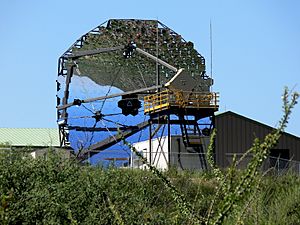Fred Lawrence Whipple Observatory facts for kids
Quick facts for kids
|
|||||||||||||||||
The Fred Lawrence Whipple Observatory is a special place in Arizona, USA, where scientists study space. It's like a giant outdoor laboratory for astronomy, which is the study of everything beyond Earth. The Smithsonian Astrophysical Observatory (SAO) owns and runs it. This observatory is their biggest research site outside of their main office in Cambridge, Massachusetts.
You can find the observatory near a town called Amado, Arizona, right on top of Mount Hopkins. Scientists here use powerful telescopes to look at distant galaxies, stars, planets in our own solar system, and even planets orbiting other stars. They also study mysterious gamma-rays and cosmic rays that come from space.
Contents
Exploring the Universe: A Look at Whipple Observatory's History
How the Observatory Began
The story of the Whipple Observatory started in 1966. That year, work began to build roads up Mount Hopkins. This was possible thanks to money given to the Smithsonian for a new observatory. Just two years later, in 1968, a special telescope called the Whipple 10-meter gamma-ray telescope was built. This telescope was designed to detect gamma rays, which are very high-energy light waves from space.
Honoring a Space Pioneer: Fred Lawrence Whipple
For a while, the observatory was simply known as the Mount Hopkins Observatory. But in 1981, it was given a new name to honor a very important person: Fred Lawrence Whipple. He was a brilliant expert on planets and a pioneer in space science. Mr. Whipple was also a former director of the SAO. He played a key role in setting up this amazing research facility in Arizona. Renaming the observatory after him was a way to recognize his great contributions to science.
Powerful Tools for Stargazing: Telescopes at Whipple Observatory
The Whipple Observatory is home to many different telescopes, each designed for specific tasks. These instruments help scientists learn more about the universe.
The MMT Observatory: A Giant Eye on the Sky
One of the most important telescopes here is part of the MMT Observatory. This huge telescope has a mirror that is 6.5 meters (about 21 feet) wide! It's a joint project between the SAO and the University of Arizona. The MMT is used to capture detailed images and study the light from distant objects in space.
Other Important Telescopes
Besides the MMT, the observatory has several other reflector telescopes. These include telescopes with mirrors that are 1.5 meters and 1.2 meters wide. There's also a 1.3-meter reflector called PAIRITEL. This name stands for "Peters Automated IR Imaging Telescope."
The observatory also hosts other cool projects:
- The HATNet (Hungarian-made Automated Telescope) network uses smaller telescopes to search for exoplanets.
- The MEarth Project also looks for exoplanets, especially those that might be similar to Earth.
- The MINERVA project uses five smaller 0.7-meter telescopes. MINERVA stands for "Miniature Exoplanet Radial Velocity Array." It helps scientists find exoplanets by looking for tiny wobbles in stars.
Pioneering Gamma-Ray Astronomy
The Whipple Observatory is famous for its groundbreaking work in studying gamma rays from the ground. In the early 1980s, scientists here developed a special method called the Imaging Atmospheric Cherenkov Technique (IACT). They used the Whipple 10-meter Telescope for this. This technique allows them to detect gamma rays that hit Earth's atmosphere. After serving for over 40 years, the Whipple 10-meter telescope is now being prepared to retire.
VERITAS: A New Generation of Gamma-Ray Telescopes
In April 2007, a new and even more powerful system called VERITAS began full operations at the observatory. VERITAS is made up of four IACT telescopes, each with a 12-meter reflector. These telescopes work together like a super-sensitive eye to detect gamma rays. In September 2009, one of the telescopes was carefully moved to make the array more balanced. This change made the VERITAS system even better at detecting faint gamma-ray signals from space.
See also
 In Spanish: Observatorio Fred Lawrence Whipple para niños
In Spanish: Observatorio Fred Lawrence Whipple para niños
- List of astronomical observatories
- Whipple (spacecraft)


